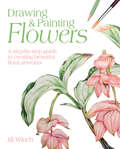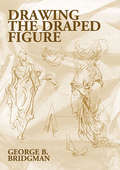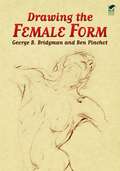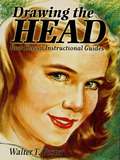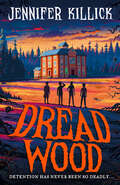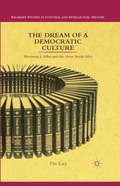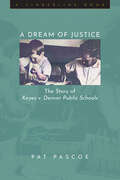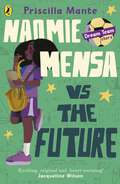- Table View
- List View
Drawing Nature: The Creative Process of an Artist, Illustrator, and Naturalist
by Linda Miller FeltnerA visually stunning exploration of the artistic process by an award-winning nature artistDrawing Nature presents the creative process of an acclaimed nature artist, guiding readers from field sketches to finished art and demonstrating how science and the close observation of nature can be integrated into the artist&’s work to create dynamic, meaningful images. With chapters that flow from drawing basics to more advanced methods and concepts, this beautifully illustrated book is like a look inside the artist&’s sketchbooks to discover their secrets.Linda Miller Feltner demonstrates how observation and recording are sparks to creativity. Her journey from loose sketches and drawings to a completed work begins with observing a natural process, object, or interaction between organisms. Her curiosity generates scientific inquiry that, when researched, helps her to answer a question or make broad, often surprising connections. Blending examples of her stunning artwork with invaluable insights into time-honored art techniques, Feltner illustrates how sketching, developing an image, and scientific accuracy are essential to her art and encourages each of us to cultivate our own powers of observation and discover anew the world around us.Drawing Nature enables us to look at nature through an artist&’s eyes, draw inspiration from a place or a moment, and give expression to its beauty.
Drawing On The Right Side Of The Brain: A Course In Enhancing Creativity And Artistic Confidence
by Betty EdwardsDrawing on the Right Side of the Brain is the world's most widely used drawing instruction book. Whether you are a professional, a student, or enjoy art as a hobby, Betty Edwards' practical step-by-step guide to drawing will give you greater confidence in your ability, deepen your artistic perception and provide a new way to appreciate the way you perceive the world around you. Edwards breaks down first steps to ensure the reader has a practical grounding that will help them improve and have fun learning more difficult techniques. Edwards gives her expert advice on what materials to use and the importance of making a record of your starting point, with three key exercises: drawing a person from memory, a self-portrait, and drawing your hand. With great advice on how to look at these first attempts, she provides the reader with a guide to measure their progress and the ability to understand what you are doing and learn from every attempt so that none are wasted. The later sections of the book focus on perceiving edges, spaces and relationships within your drawing before applying these skills in solving problems and ultimately being free to continue on your own. Edwards will help you to shift to the right side of the brain that utilises more intuitive and artistic aspects of thinking.
Drawing on Students’ Worlds in the ELA Classroom: Toward Critical Engagement and Deep Learning
by Richard BeachThis book approaches English instruction through the lens of “fi gured worlds,” which recognizes and spotlights how students are actively engaged in constructing their own school, peer group, extracurricular, and community worlds. Teachers’ ability not only to engage with students’ experiences and interests in and outside of school but also to build connections between students’ worlds and their teaching is essential for promoting student agency, engagement, and meaningful learning. Beach and Caraballo provide an accessible framework for working with students to use critical discourse, narratives, media, genres, and more to support their identity development through addressing topics that are meaningful for them— their families, social issues, virtual worlds, and more. Through extensive activities and examples of students writing about their participation in these worlds, this text allows educators to recognize how students’ experiences in the classroom aff ect and shape their identities and to connect such an understanding to successful classroom practice. With chapters featuring eff ective instructional activities, this book is necessary reading for ELA methods courses and for all English teachers.
Drawing on Students’ Worlds in the ELA Classroom: Toward Critical Engagement and Deep Learning
by Richard BeachThis book approaches English instruction through the lens of “fi gured worlds,” which recognizes and spotlights how students are actively engaged in constructing their own school, peer group, extracurricular, and community worlds. Teachers’ ability not only to engage with students’ experiences and interests in and outside of school but also to build connections between students’ worlds and their teaching is essential for promoting student agency, engagement, and meaningful learning. Beach and Caraballo provide an accessible framework for working with students to use critical discourse, narratives, media, genres, and more to support their identity development through addressing topics that are meaningful for them— their families, social issues, virtual worlds, and more. Through extensive activities and examples of students writing about their participation in these worlds, this text allows educators to recognize how students’ experiences in the classroom aff ect and shape their identities and to connect such an understanding to successful classroom practice. With chapters featuring eff ective instructional activities, this book is necessary reading for ELA methods courses and for all English teachers.
Drawing & Painting Flowers: A Step-by-Step Guide to Creating Beautiful Floral Artworks
by Jill WinchLearn how to capture the beauty of nature in pencil, pen and watercolour with this inspiring guide from award-winning botanical artist Jill Winch. The first half of the book shows you how to capture the shape, form and texture of a wide range of flowers and their leaves in pencil and in pen and wash. The second part shows how to work in watercolour, the medium of choice for most botanical artists, to create exquisite colour artworks.Drawing and Painting Flowers is packed with examples and exercises across the full floral range, from simple structures, such as tulips, to more complex configurations, such as sunflowers, and compositions involving groups of flowers.It also gives advice on practical considerations such as how best to position flowers when drawing or painting, how to prevent them wilting and how to use a microscope to understand their structure.
Drawing Portraits: A Practical Course for Artists (A Practical Course for Artists)
by Barrington BarberA portrait can reveal the likeness, personality, and even the mood of a person. In previous centuries, portraits were used to reveal someone's social standing, to manipulate the viewer's opinion of the subject, or to exaggerate and accentuate features.In Drawing Portraits, artist and teacher Barrington Barber shows you how to overcome common difficulties and introduces you to the techniques that will develop your perception of a subject.• Includes information on materials, techniques, and styles• Covers the basics of proportions, facial expressions, and poses• Teaches the art of group and animal portraits and caricatures• Contains step-by-step drawings and exercises to practise
Drawing Projects Made Easy: Step-by-step instruction for beginners
by Barrington BarberBest-selling author Barrington Barber presents a range of exciting projects, from simple still lifes and full-blown landscape compositions to individual portraits. His systematic teaching method ensures that you quickly acquire the techniques you need to complete sets of drawings that any aspiring artist would be proud of.• Rather than teaching by rote, this book inspires readers to discover their own individual style of drawing.• The material here works for complete beginners as well as those who are looking to improve their skills.• Fully illustrated throughout by the author.
Drawing Still Life: A Practical Course for Artists (A Practical Course for Artists)
by Barrington BarberStill life has been a popular form of art for many hundreds of years, offering a wide choice of subjects, styles, and scale. Whether you want to work outdoors or at home, with carefully detailed studies or bold sweeps of line, with classical subjects or simple objects that you might find in your home, you will never be at a loss to find inspiration.In Drawing Still Life, Barrington Barber explores this genre in all its richness. A teacher as well as a working artist, his clear and comprehensive instruction for artists of all levels is supported by easy-to-follow illustrations.• Includes information and advice on materials and techniques• Covers ways of representing different objects and textures• Looks at different approaches to combining objects, themes, and at composition• Offers step-by-step drawings and exercises to practise
Drawing the Draped Figure
by George B. BridgmanMany art students and professionals have mastered the art of depicting unclothed figures, but still have trouble accurately rendering clothing or other forms of draped cloth. Part of the problem — before this book came along — was that there was a lack of concise and simple instruction on the subject, and much that was written was too vague to be helpful. This comprehensive, well-illustrated book was created to solve the problem.In these pages George Bridgman — a longtime instructor at New York's Art Student League and one of the nation's foremost teachers of figure drawing — offers expert advice on depicting draped figures. "Clothing is none other than a drapery arranged around a body that is beneath it. To express the multitudinous forms it takes, one should learn to express in a direct way the different characters of folds, for each one plays its individual part as distinctly apart as actors play their different characters upon the stage."Students learn the characteristics of seven different kinds of folds and how to render them, including pipe, zigzag, spiral, half-lock, diaper pattern, drop, and inert folds. Mastery of these principles is the key to realistic portrayal of garments, as well as the proper rendering of cloth in still lifes. The straightforward, easy-to-follow text is illustrated by 200 of Bridgman's own sketches and diagrams, reproduced from pencil renderings in crisp halftones. Art students, teachers, and professionals alike are sure to welcome this inexpensive republication of a practical, hands-on manual by a master of figure drawing.
Drawing the Female Form
by George B. Bridgman Ben PinchotDesigned primarily for beginning artists, this excellent reference combines the precise results of the photographed figure with progressive drawings by a noted figure-drawing teacher whose works on anatomy have become classic references for art students.The well-illustrated manual provides painters, illustrators, and sculptors with invaluable instructions on rendering the intricacies of the female figure. George Bridgman's use of photographs and his drawings provide beginning artists with a suitable alternative to the use of costly live models for drawing exercises and studies in musculature and light.
Drawing the Head: Four Classic Instructional Guides
by Walter T. FosterAn accomplished artist and teacher, Walter T. Foster began producing his classic art instruction books in the 1920s. He wrote, illustrated, printed, bound, packaged, shipped, and distributed his books from his own home for decades, before moving the business to a commercial facility to accommodate his international trade. This comprehensive volume combines four of the artist's vintage instructional manuals to form an essential guide to illustrating the head and face. "Let your drawing be simple," Foster advises, and suggests that art students begin with the profile. Leave out unnecessary details until the basic shapes are in place. Then add the expressions that make the face the most interesting of all subjects. Instructions include step-by-step diagrams using charcoal, crayon, pencil, and brush to create finished portraits, plus tips on materials. With an array of subjects that include men, women, and children of various ages and ethnic types, this guide captures the mid-twentieth-century style of illustration to inspire today's artists.
Drawing the Line: Technical Hand Drafting for Film and Television
by David McHenryThis is the definitive guide for all aspects of scenic hand drafting for film and television, now comprehensively updated and revised for its second edition. Author, David McHenry, utilizes 45 years of experience as a Designer, Art Director, Storyboard Artist, and Draftsman to provide readers with an accessible step-by-step guide of professional techniques, tools, and workflows. Readers will discover how to draw the iconic scroll of a classical column or learn the difference between Flemish and English bond brickwork, as well as all four types of drafting projection in detail: isometric, oblique, orthographic, and axonometric. Also included is hard-to-find information on lens angles and their calculation for different screen aspect ratios, how to create a lens projection image of a set with a given lens, height, and aspect ratio, and how to create forced perspective. Beautifully illustrated with carefully crafted hand-drawn illustrations on every page, this thoroughly revised text has been updated to include new examples and exercises and a revised glossary, making it the ideal step-by-step guide to hand drafting for film and television. This is an essential resource for students of drafting for film and television, scenic design, and art direction courses. It will also hugely benefit professionals studying or working in film and television design.
Drawing the Line: Technical Hand Drafting for Film and Television
by David McHenryDrawing the Line: Technical Hand Drafting for Film and Television is the essential resource for students and aspiring professionals studying and working in film and television design. The book covers all aspects of scenic drafting by hand – a technique still used in film and television because of its unparalleled emotive and aesthetic qualities. Discover how to draw the iconic scroll of a classical column or learn the difference between Flemish bond and English bond brickwork – it is all here! Other key features include the following: Beautifully illustrated, approachable, step-by-step instructions for every aspect of scenic drafting – specific to film and television; Illustrated explanations of camera lenses, including calculating aspect ratios and projections; Coverage of the four types of drafting projection: isometric, oblique, orthographic and axonometric; A comprehensive glossary of terms, including an illustration of each entry. This beautiful book is clear, accessible, and a must-have for any student aspiring to work in film and television design.
Drawing Trees
by Victor PerardThis concise guide features easy-to-follow steps for capturing the natural beauty and magnificence of trees. Over 100 illustrations spotlight dozens of different varieties, including Oak, Willow, Pine, and Palmetto. Topics include shading techniques, composition, portraying shadow and light, and approaches to outlining.Author and illustrator Victor Perard, a graduate of the École des Beaux-Arts in Paris, was an art instructor at New York City's Cooper Union for twenty years. This informative volume reflects his extensive teaching experience and provides practical advice for artists at every level.
Drawing Unicorns & Other Mythical Creatures
by Peter GrayStep into the spell-binding world of folk tales and magic with this wonderful guide to drawing unicorns and other mystical creatures, illustrated in full-color Renowned artist Peter Gray takes readers through step-by-step drawing projects to create an array of enchanting animals, including unicorns, gryphons, centaurs, dragons and Pegasus, the winged horse. Taking inspiration from flowers and the natural world, readers will learn how to create environments for all these creatures that sparkle and delight. Includes: • Step-by-step instructions from initial shapes to full-color artwork. • A varied range of types of unicorns and other magical creatures. • Detailed instruction on how to draw mythical beasts in all their power and beauty. This accessible drawing guide is perfect for anyone who wants to create their own fantasy worlds.
Drawings of People by the Under-5s
by Dr Maureen Cox Maureen CoxThis work traces the development of the human figure in children's drawings, showing how children add to and alter their figures as they get older and more skilful. It discusses why children's drawings often seem so bizarre to adults, revealing what these figures tell as about the child's Intelligence Or Emotional Stability.; The Book Is Based In Examples From hundreds of children, but concentrates on a particular set of drawings gathered from one group of children attending a nursery. Also featured are drawings by children with learning difficulties, so that readers may see and learn from the different developmental patterns in the drawing of human figures. Additionally, the book makes comparisons of drawings by children in different cultures.
Drawings of People by the Under-5s
by Dr Maureen Cox Maureen CoxThis work traces the development of the human figure in children's drawings, showing how children add to and alter their figures as they get older and more skilful. It discusses why children's drawings often seem so bizarre to adults, revealing what these figures tell as about the child's Intelligence Or Emotional Stability.; The Book Is Based In Examples From hundreds of children, but concentrates on a particular set of drawings gathered from one group of children attending a nursery. Also featured are drawings by children with learning difficulties, so that readers may see and learn from the different developmental patterns in the drawing of human figures. Additionally, the book makes comparisons of drawings by children in different cultures.
Drawn to the Flame: Teachers’ Stories of Burnout (Advances in Research on Teaching #45)
by ERIN A. SINGER, MATTHEW J. ETCHELLS, CHERYL J. CRAIGTeacher attrition and burnout have been researched in school districts all over the country for several decades. Characterised by physical and psychological exhaustion, cynicism (as an interpersonal and emotional indication of built-up aggression), and a sense of helplessness and low self-efficacy, burnout can lead to anxiety, depression, diminished job performance, absenteeism, and attrition. Drawn to the Flame investigates incidences of burnout and burnout avoidance among educators in both K-12 and higher education spheres during the COVID-19 pandemic – a period that saw an intensification and increased frequency of polarizing sociocultural and socio-political conditions, resulting in psychosocial and emotional strain among those invested in education. Through narrative inquiry, the chapters present the stories of teachers in a variety of settings (e.g. urban, suburban, rural) and sociological conditions (economic, racial, sex/gender), who experienced first-hand the impact of the pandemic and the chaotic transition to remote learning, the impact of the U.S. Immigration and Customs Enforcement (ICE) and racial strife, on students and curricular planning processes.
Drawn to the Flame: Teachers’ Stories of Burnout (Advances in Research on Teaching #45)
by Erin A. Singer Matthew J. Etchells Cheryl J. CraigTeacher attrition and burnout have been researched in school districts all over the country for several decades. Characterised by physical and psychological exhaustion, cynicism (as an interpersonal and emotional indication of built-up aggression), and a sense of helplessness and low self-efficacy, burnout can lead to anxiety, depression, diminished job performance, absenteeism, and attrition. Drawn to the Flame investigates incidences of burnout and burnout avoidance among educators in both K-12 and higher education spheres during the COVID-19 pandemic – a period that saw an intensification and increased frequency of polarizing sociocultural and socio-political conditions, resulting in psychosocial and emotional strain among those invested in education. Through narrative inquiry, the chapters present the stories of teachers in a variety of settings (e.g. urban, suburban, rural) and sociological conditions (economic, racial, sex/gender), who experienced first-hand the impact of the pandemic and the chaotic transition to remote learning, the impact of the U.S. Immigration and Customs Enforcement (ICE) and racial strife, on students and curricular planning processes.
Dread Wood (Dread Wood #1)
by Jennifer KillickThe brand new must-read middle-grade novel from the author of super-spookyCrater Lake. Perfect for 9+ fans of R.L.Stine’s Goosebumps
The Dream of a Democratic Culture: Mortimer J. Adler and the Great Books Idea (Palgrave Studies in Cultural and Intellectual History)
by T. LacyThis book presents a moderately revisionist history of the great books idea anchored in the following movements and struggles: fighting anti-intellectualism, advocating for the liberal arts, distributing cultural capital, and promoting a public philosophy, anchored in mid-century liberalism, that fostered a shared civic culture.
A Dream of Justice: The Story of Keyes v. Denver Public Schools (Timberline Books)
by Pat PascoeA Dream of Justice is Colorado state senator and former teacher Pat Pascoe’s firsthand account of the decades-long fight to desegregate Denver’s public schools. Drawing on oral histories and interviews with members of the legal community, parents, and students, as well as extensive institutional records, Pascoe offers a compelling social history of Keyes v. School District No. 1 (Denver). Pascoe details Denver’s desegregation battle, beginning with the citizen studies that exposed the inequities of segregated schools and Rachel Noel’s resolution to integrate the system, followed by the momentous pro-integration Benton-Pascoe campaign of Ed Benton and Monte Pascoe for the school board in 1969. When segregationists won that election and reversed the integration plan for northeast Denver, Black, white, and Latino parents filed Keyes v. School District No. 1. This book follows the arguments in the case through briefs, transcripts, and decisions from district court to the Supreme Court of the United States and back, to its ultimate order to desegregate all Denver schools “root and branch.” It was the first northern city desegregation suit to be brought before the Supreme Court. However, with the end of court-ordered busing in 1995, schools quickly resegregated and are now more segregated than before Keyes was filed. Pascoe asserts that school integration is a necessary step toward eliminating systemic racism in our country and should be the objective of every school board. A Dream of Justice will appeal to students, scholars, and readers interested in the history of civil rights in America, Denver history, and the history of US education.
The Dream Team: Naomie Mensa vs. the Future (The Dream Team #3)
by Priscilla ManteThe third story in the heart-warming, inclusive and funny Dream Team series about three big F's: friends, football and following your dreams!Hey! My name's Naomie Osei, but my friends call me Mensa, cos I'm supposed to be the clever one among my friends, the Fabulous Four. Normally I'm the one with all the answers, but right now I'm struggling to figure out our future.I mean, how do I break it to my friends that I might not be going to the same high school as them next term? Is my sax-playing good enough for the big solo at the Midsummer Concert? And can Bramrock's top girl's football team, the Dreamers, save our library from closing?Since I can't tell the future, I kind of want to press pause and stay in the present a bit longer. But as that's impossible, I suppose I'll have to do what I'm best at and work out the solution . . .
Dream Teams: Working Together Without Falling Apart
by Shane Snow'An adventure into the very human science of making breakthroughs together.' - Charles Duhigg, Pulitzer Prize-winning journalist and author of The Power of HabitThe best groups are more than the sum of their parts - but why does teamwork so often fail to fulfill this promise? Award-winning entrepreneur and journalist Shane Snow takes us on an extraordinary tour of the hidden science of team dynamics, revealing the counterintuitive reasons that some groups break out while far too many break down.Examining history-making groups like the Wu Tang Clan and the Russian national hockey side alongside teams whose failures have had lasting impact, Snow reveals the answers, and what the rest of us can learn from the rare teams that do the impossible together. In this stimulating, pacey adventure through history, neuroscience, psychology, sports and business, Snow explores the secrets of the best teams the world has to offer. You'll discover: - How ragtag teams - from soccer clubs to startups to gangs of pirates - beat the odds throughout history- Why DaimlerChrysler flopped while the Wu-Tang Clan succeeded, and the surprising factor behind most failed mergers, marriages, and partnerships- What the Wright Brothers' daily arguments can teach us about group problem solving- The true stories of pioneering women in law enforcement, unlikely civil rights collaborators, and underdog armies that did the incredible together- The team players behind great social movements in history, and the science of becoming open-minded.Provocative and entertaining, Dream Teams is a landmark work that will change the way we think about progress and collaboration.
Dream Wakers: Mentor Texts That Celebrate Latino Culture
by Ruth CulhamThere is power that resides in outstanding culturally diverse literature'sa power that has the potential to engage students in reading and teach them about the art and craft of writing. 'sRuth Culham We dream of a time when all students will be confident, capable readers and writers. When we teach students to read as writers using mentor texts, we awaken that dream and make it real. Imagine the power of providing students with books that show them their faces, their culture, their lives on every page. And imagine how every classroom's collection of mentor texts can grow by adding books that celebrate diversity. In Dream Wakers: Mentor Texts That Celebrate Latino Culture, Ruth Culham focuses her love of children's literature'sand her decades of work developing the traits of writing'son books that celebrate Latino life and culture. She provides a wide variety of ideas to teach writing using some of the richest and most beautiful children's books available. Dream Wakers gives you: • An annotated list of more than 120 books with do-it-today lesson ideas for teaching the traits of writing'sIdeas, Organization, Voice, Word Choice, Sentence Fluency, and Conventions. More than half of the books listed are bilingual or offer English and/or Spanish editions. • Eleven original, insightful essays by renowned children's authors of some of the featured books • A handy reference chart that helps teachers locate books quickly by trait, genre, language, and author/publisher information. Ruth encourages all of us to make sure students of all backgrounds have access to high-quality, culturally diverse texts and recognize the difference those texts will make in their reading lives, as well as in their perception of themselves as a thinkers, learners, and citizens.



